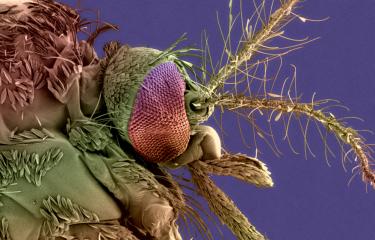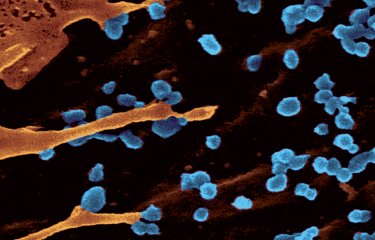Researchers from the Institut Pasteur and CNRS have identified for the first time the target cells of the Chikungunya virus disease (the "stooped man's disease"), which is currently breaking out in India and Gabon. Their results, obtained in collaboration with clinicians from the island of Reunion, were published in PLoS Pathogens and in PLoS ONE.
Press release
Paris, june 29, 2007
The Chikungunya virus, discovered in Tanzania in 1952, and the disease that it causes have been little studied up until now. An epidemic outbreak recently occurred in the islands of the Indian Ocean in 2005-2006 (270,000 cases in La reunion island). Chikungunya had also recently caused a vast epidemic in India, where it caused from 1.4 to 6.5 million cases between 2005 and 2007, before it reached Gabon, where 11,500 cases have been reported since mid-April of 2007.
The Institut Pasteur has mobilized a dozen scientific teams to study this neglected disease. Notably, last year, the Institut Pasteur teams were able to trace the history of the evolution of the Chikungunya virus in the Indian Ocean, by sequencing several strains of the virus that circulated during the epidemic (see the press release for May 23, 2006).
One important question to understand the mechanisms of disease is to determine the tropism of the virus: which cells in the organism are infected? The goal of the study that is published today in PLoS Pathogens was to answer to this question. The study was carried out by a team led by Olivier Schwartz from the Institut Pasteur's Virus and Immunity Unit (CNRS URA 3015) in collaboration with several other teams from the Institut Pasteur and the Reunion South Hospital Group.
The researchers have first designed appropriate tools (flow cytometry, immunofluorescence, electronic microscopy, etc) that allowed the visualization and quantification of the virus. They were able to show in cell culture experiments that, while the virus did not multiply in circulating blood cells (lymphocytes and monocytes), it did replicate in macrophages (phagocytic cells that originate in the blood and are localized in tissues). These cells can therefore be implicated in the infection of tissues that are affected by the disease, such as muscles and joints. The virus also infects the so-called "adherent" cells: endothelial cells, epithelial cells, fibroblasts, etc. The researchers also determined how the virus enters the cells; their next aim is to describe the interactions between the virus and the immune system. It is also intended in the future to perform drug screening assays to identify drugs blocking CHIKV replication.
On the other hand, Pierre-Emmanuel Ceccaldi and Simona Ozden from the Institut Pasteur's Oncogenic Epidemiology and Pathophysiology Unit, CNRS URA 3015, led by Antoine Gessain, carried out another study in collaboration with several other teams from the Institut Pasteur and the Institute for Myology in Paris, as well as clinicians from Saint-Denis de la Réunion, that demonstrated that certain cells in the muscular tissue of persons infected with the Chikungunya virus were targeted by that virus. Their work, recently published in PLoS ONE, was supported by the study of biopsies obtained from infected patients. They found in one biopsy from a patient in the acute phase of the disease and in another one from a patient at a later stage that precursor muscle cells - satellite cells - had been infected by the virus. Moreover, in cell cultures the precursor cells proved to be very permissive to the virus. The authors would like now to determine whether these cells could play a role as a "reservoir" for the virus, which would explain the recurrence of muscle pain that has been observed in certain patients.
The strong mobilization of the Institut Pasteur researchers, is illustrated by ongoing studies on virus transmission from mother to infant, on the physiopathology of the disease, the interaction between the virus and mosquito vectors, and the sequencing of virus strains that are currently circulating in Gabon*.
* In collaboration with the IMTSSA tropical virology unit at Marseille
Chick
Chikungunya virus particles budding from the surface of an infected human cell © O. Schwartz/Institut Pasteur
Sources
1) "Characterization of reemerging Chikungunya virus" : PLoS Pathogens, 29 juin 2007.
Marion Sourisseau (1), Clémentine Schilte (2), Nicoletta Casartelli (1), Céline Trouillet (1), Florence Guivel-Benhassine (1), Dominika Rudnicka (1), Nathalie Sol-Foulon (1), Karin Le Roux (9), Marie-Christine Prevost (3), Hafida Fsihi (4), Marie-Pascale Frenkiel (5), Fabien Blanchet (1), Philippe V.Afonso (6), Pierre-Emmanuel Ceccaldi (6), Simona Ozden (6), Antoine Gessain (6), Isabelle Schuffenecker (10), Bruno Verhasselt (11), Alessia Zamborlini (12), Ali Saib (12), Felix A. Rey (7), Fernando Arenzana-Seisdedos (8), Philippe Desprès (5), Alain Michault (9), Matthew L. Albert (2) et Olivier Schwartz (1)
1. Virus and Immunity Unit, Institut Pasteur, Paris
2. Immunobiology and Dendrite Cells Unit, Inserm U818, Institut Pasteur
3. Electron Microscopy Platform, Institut Pasteur
4. Department for Infection and Epidemiology, Institut Pasteur
5. Flavivirus-Host Molecular Interactions Unit, Institut Pasteur, Paris
6. Oncogenic Epidemiology and Pathophysiology Unit, Institut Pasteur
7. Bacterial Molecular Genetics Unit, Institut Pasteur
8. Molecular Microbial Pathogenesis Unit, Institut Pasteur, Paris, France
9. Laboratory of Microbiology, Reunion South Hospital Group, Reunion Island
10. National Arbovirus Reference Center, Lyon
11. Ghent University, Belgium; 12 Hôpital Saint-Louis, Paris. / 1,6,7,8: CNRS URA 3015
(2) "Human muscle satellite cells as targets of Chikungunya virus infection": PLoS ONE, 13 juin 2007.
Simona Ozden (1), Michel Huerre (2), Jean-Pierre Riviere (3), Lark L. Coffey (4), Philippe V. Afonso (1), Vincent Mouly (5), Jean de Monredon (6), Jean-Christophe Roger (6), Mohamed El Amrani (6), Jean-Luc Yvin (7), Marie-Christine Jaffar (8), Marie-Pascale Frenkiel (4), Marion Sourisseau (9), Olivier Schwartz (9), Gillian Butler-Browne (5), Philippe Desprès (4), Antoine Gessain (1) et Pierre-Emmanuel Ceccaldi (1)
1. Oncogenic Virus Epidemiology and Physiopathology Unit - CNRS URA 1930, Institut Pasteur
2. Histotechnology and Pathology Expert Research Unit, Institut Pasteur
3. Anatomic Pathology Department, CHD Félix Guyon, Saint-Denis de la Réunion
4. Flavivirus-Host Molecular Ineractions Unit, Institut Pasteur, Paris
5. Inserm U787 - Université Pierre et Marie Curie - Institute for Myology, Pitié Salpétrière, Paris
6. Neurology Department, CHD Félix Guyon, Saint-Denis de la Réunion
7. Internal Medicine Department, CHD Félix Guyon, Saint-Denis de la Réunion
8. Biology Laboratory, CHD Félix Guyon, Saint-Denis de la Réunion
9. Virus and Immunity Unit, Institut Pasteur, Paris
Contact persons
- Institut Pasteur Press Department, Nadine Peyrolo or Corinne Jamma:
01 40 61 33 41 / cjamma@pasteur.fr
- CNRS - Press Office:
01 44 96 43 09 / cecile.perol@cnrs-dir.fr




